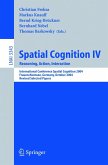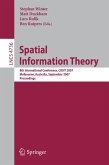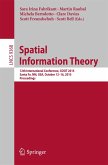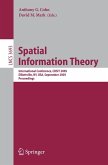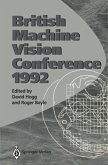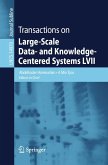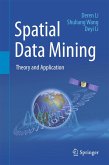Spatial Cognition II (eBook, PDF)
Integrating Abstract Theories, Empirical Studies, Formal Methods, and Practical Applications
Redaktion: Freksa, Christian; Wender, Karl F.; Habel, Christopher; Brauer, Wilfried
40,95 €
40,95 €
inkl. MwSt.
Sofort per Download lieferbar

20 °P sammeln
40,95 €
Als Download kaufen

40,95 €
inkl. MwSt.
Sofort per Download lieferbar

20 °P sammeln
Jetzt verschenken
Alle Infos zum eBook verschenken
40,95 €
inkl. MwSt.
Sofort per Download lieferbar
Alle Infos zum eBook verschenken

20 °P sammeln
Spatial Cognition II (eBook, PDF)
Integrating Abstract Theories, Empirical Studies, Formal Methods, and Practical Applications
Redaktion: Freksa, Christian; Wender, Karl F.; Habel, Christopher; Brauer, Wilfried
- Format: PDF
- Merkliste
- Auf die Merkliste
- Bewerten Bewerten
- Teilen
- Produkt teilen
- Produkterinnerung
- Produkterinnerung

Bitte loggen Sie sich zunächst in Ihr Kundenkonto ein oder registrieren Sie sich bei
bücher.de, um das eBook-Abo tolino select nutzen zu können.
Hier können Sie sich einloggen
Hier können Sie sich einloggen
Sie sind bereits eingeloggt. Klicken Sie auf 2. tolino select Abo, um fortzufahren.

Bitte loggen Sie sich zunächst in Ihr Kundenkonto ein oder registrieren Sie sich bei bücher.de, um das eBook-Abo tolino select nutzen zu können.
This book constitutes the second volume documenting the results achieved within a priority program on spatial cognition by the German Science Foundation (DFG).The 28 revised full papers presented were carefully reviewed and reflect the increased interdisciplinary cooperation in the area. The book is divided into sections on maps and diagrams, motion and spatial reference, spatial relations and spatial inference, navigation in real and virtual spaces, and spatial memory.
- Geräte: PC
- ohne Kopierschutz
- eBook Hilfe
- Größe: 8.16MB
Andere Kunden interessierten sich auch für
![Spatial Cognition IV, Reasoning, Action, Interaction (eBook, PDF) Spatial Cognition IV, Reasoning, Action, Interaction (eBook, PDF)]() Spatial Cognition IV, Reasoning, Action, Interaction (eBook, PDF)73,95 €
Spatial Cognition IV, Reasoning, Action, Interaction (eBook, PDF)73,95 €![Spatial Information Theory (eBook, PDF) Spatial Information Theory (eBook, PDF)]() Spatial Information Theory (eBook, PDF)40,95 €
Spatial Information Theory (eBook, PDF)40,95 €![Spatial Information Theory (eBook, PDF) Spatial Information Theory (eBook, PDF)]() Spatial Information Theory (eBook, PDF)40,95 €
Spatial Information Theory (eBook, PDF)40,95 €![Spatial Information Theory (eBook, PDF) Spatial Information Theory (eBook, PDF)]() Spatial Information Theory (eBook, PDF)40,95 €
Spatial Information Theory (eBook, PDF)40,95 €![BMVC92 (eBook, PDF) BMVC92 (eBook, PDF)]() BMVC92 (eBook, PDF)40,95 €
BMVC92 (eBook, PDF)40,95 €![Transactions on Large-Scale Data- and Knowledge-Centered Systems LVII (eBook, PDF) Transactions on Large-Scale Data- and Knowledge-Centered Systems LVII (eBook, PDF)]() Transactions on Large-Scale Data- and Knowledge-Centered Systems LVII (eBook, PDF)48,95 €
Transactions on Large-Scale Data- and Knowledge-Centered Systems LVII (eBook, PDF)48,95 €![Spatial Data Mining (eBook, PDF) Spatial Data Mining (eBook, PDF)]() Deren LiSpatial Data Mining (eBook, PDF)65,95 €
Deren LiSpatial Data Mining (eBook, PDF)65,95 €-
-
-
This book constitutes the second volume documenting the results achieved within a priority program on spatial cognition by the German Science Foundation (DFG).The 28 revised full papers presented were carefully reviewed and reflect the increased interdisciplinary cooperation in the area. The book is divided into sections on maps and diagrams, motion and spatial reference, spatial relations and spatial inference, navigation in real and virtual spaces, and spatial memory.
Dieser Download kann aus rechtlichen Gründen nur mit Rechnungsadresse in A, B, BG, CY, CZ, D, DK, EW, E, FIN, F, GR, HR, H, IRL, I, LT, L, LR, M, NL, PL, P, R, S, SLO, SK ausgeliefert werden.
Produktdetails
- Produktdetails
- Verlag: Springer Berlin Heidelberg
- Seitenzahl: 424
- Erscheinungstermin: 26. Juni 2003
- Englisch
- ISBN-13: 9783540454601
- Artikelnr.: 53396304
- Verlag: Springer Berlin Heidelberg
- Seitenzahl: 424
- Erscheinungstermin: 26. Juni 2003
- Englisch
- ISBN-13: 9783540454601
- Artikelnr.: 53396304
- Herstellerkennzeichnung Die Herstellerinformationen sind derzeit nicht verfügbar.
Maps and Diagrams.- Cognitive Zoom: From Object to Path and Back Again.- Monitoring Change: Characteristics of Dynamic Geo-spatial Phenomena for Visual Exploration.- The Use of Maps, Images and "Gestures" for Navigation.- Schematizing Maps: Simplification of Geographic Shape by Discrete Curve Evolution.- Schematic Maps as Wayfinding Aids.- Some Ways that Maps and Diagrams Communicate.- Spatial Communication with Maps: Defining the Correctness of Maps Using a Multi-Agent Simulation.- Schematic Maps for Robot Navigation.- Motion and Spatial Reference.- From Motion Observation to Qualitative Motion Representation.- Lexical Specifications of Paths.- Visual Processing and Representation of Spatio-temporal Patterns.- Orienting and Reorienting in Egocentric Mental Models.- Investigating Spatial Reference Systems through Distortions in Visual Memory.- Spatial Relations and Spatial Inference.- Towards Cognitive Adequacy of Topological Spatial Relations.- Interactive Layout Generation with a Diagrammatic Constraint Language.- Inference and Visualization of Spatial Relations.- A Topological Calculus for Cartographic Entities.- The Influence of Linear Shapes on Solving Interval-Based Configuration Problems.- Navigation in Real and Virtual Spaces.- Transfer of Spatial Knowledge from Virtual to Real Environments.- Coarse Qualitative Descriptions in Robot Navigation.- Oblique Angled Intersections and Barriers: Navigating through a Virtual Maze.- Modelling Navigational Knowledge by Route Graphs.- Using Realistic Virtual Environments in the Study of Spatial Encoding.- Navigating Overlapping Virtual Worlds: Arriving in One Place and Finding that You're Somewhere Else.- Spatial Memory.- Influences of Context on Memory for Routes.- Preparing a Cup of Tea and Writing a Letter: DoScript-Based Actions Influence the Representation of a Real Environment?.- Action Related Determinants of Spatial Coding in Perception and Memory.- Investigation of Age and Sex Effects in Spatial Cognitions as Assessed in a Locomotor Maze and in a 2-D Computer Maze.
Maps and Diagrams.- Cognitive Zoom: From Object to Path and Back Again.- Monitoring Change: Characteristics of Dynamic Geo-spatial Phenomena for Visual Exploration.- The Use of Maps, Images and "Gestures" for Navigation.- Schematizing Maps: Simplification of Geographic Shape by Discrete Curve Evolution.- Schematic Maps as Wayfinding Aids.- Some Ways that Maps and Diagrams Communicate.- Spatial Communication with Maps: Defining the Correctness of Maps Using a Multi-Agent Simulation.- Schematic Maps for Robot Navigation.- Motion and Spatial Reference.- From Motion Observation to Qualitative Motion Representation.- Lexical Specifications of Paths.- Visual Processing and Representation of Spatio-temporal Patterns.- Orienting and Reorienting in Egocentric Mental Models.- Investigating Spatial Reference Systems through Distortions in Visual Memory.- Spatial Relations and Spatial Inference.- Towards Cognitive Adequacy of Topological Spatial Relations.- Interactive Layout Generation with a Diagrammatic Constraint Language.- Inference and Visualization of Spatial Relations.- A Topological Calculus for Cartographic Entities.- The Influence of Linear Shapes on Solving Interval-Based Configuration Problems.- Navigation in Real and Virtual Spaces.- Transfer of Spatial Knowledge from Virtual to Real Environments.- Coarse Qualitative Descriptions in Robot Navigation.- Oblique Angled Intersections and Barriers: Navigating through a Virtual Maze.- Modelling Navigational Knowledge by Route Graphs.- Using Realistic Virtual Environments in the Study of Spatial Encoding.- Navigating Overlapping Virtual Worlds: Arriving in One Place and Finding that You're Somewhere Else.- Spatial Memory.- Influences of Context on Memory for Routes.- Preparing a Cup of Tea and Writing a Letter: DoScript-Based Actions Influence the Representation of a Real Environment?.- Action Related Determinants of Spatial Coding in Perception and Memory.- Investigation of Age and Sex Effects in Spatial Cognitions as Assessed in a Locomotor Maze and in a 2-D Computer Maze.

